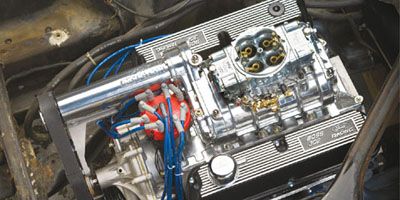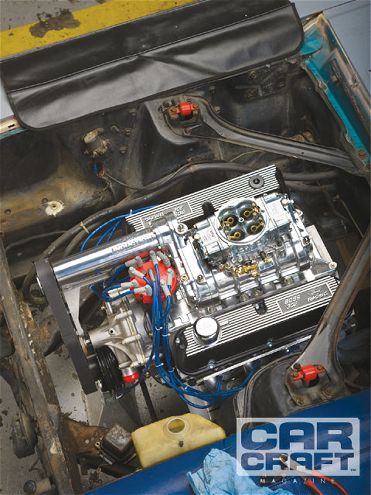
 Last month we tested Ford Racing's new Boss 302 with three different intake manifolds to help you choose the correct one for your next Ford project. In the end, the Weiand Action Plus made the most usable power with the stock crate engine. The final intake manifold had Teflon-treated rotors and made a whistling sound. We saved it for this issue.
Last month we tested Ford Racing's new Boss 302 with three different intake manifolds to help you choose the correct one for your next Ford project. In the end, the Weiand Action Plus made the most usable power with the stock crate engine. The final intake manifold had Teflon-treated rotors and made a whistling sound. We saved it for this issue.
Boost! For fixing the stock torque and horsepower curves on the dyno chart and roasting rubber with a tap of the throttle, nothing beats it. And for producing a big kick in the seat when you punch it, nothing beats a Roots-type blower. The numbers and grin factor never lie, and we've proved it once again by bolting a Weiand 174 supercharger on to the Ford Racing Boss 302 crate engine that we tested in last month's issue.
Why a Roots blower and not a centrifugal? In the real world of street-driven engines, you want torque down low in the rpm band to have fun. The Roots-style blower delivers that by ensuring you get maximum cfm as early as possible. In the case of the 174 series, you get 174 cfm with one revolution of the rotors, and that happens right away. Centrifugal blowers and turbos require time and rpm to produce boost. Compared with the 302 we tested in the Dec. '07 issue with a centrifugal supercharger, the Roots-style produced an additional pound of boost off of idle through the low end of the power curve. At 4,000 rpm, the centrifugal kicked in and eventually produced more boost to the top of the curve. Factors such as pulley ratios, restrictions in cylinder head flow, and cam timing are significant in this comparison, but our testing proved that the theory is sound.
Another benefit to the Roots-style blower is low cost and absolute simplicity. Entry-level centrifugals are usually $300 to $400 more than the Roots and require a carburetor hat or enclosure, a blow-off valve, and some way to boost-reference the fuel system, since the fuel bowls are also under boost pressure. The Roots blower swaps on like an intake manifold and requires a power-valve reference only. We love the centrifugal for huge freakin' top-end power, but we also love the Roots for its quick grunt, street machine looks, and ease of installation. Choosing between the two was a tough call. We've tested both on 302 engines recently and printed them in the magazine, so it's up to you to compare and choose your fun. Remember, when you're making close to 500 hp, it's OK to have stuff sticking out of the hood.
Boosted Fun
As you can see, the blower added 89 lb-ft of torque and 134 hp with one bolt-on. Also note that it added 700 rpm to the powerband and a huge area of torque between 2,500 and 6,000 rpm.
Why Not The 8-71?
The Weiand 174 is ideal for the Boss 302 crate engine running pump gas. Small blowers can be overdriven to produce more boost at lower engine speeds and as a result, start generating additional torque and horsepower as low as 1,000 rpm. In a street car that lives around 4,500 rpm, you are always in the fat part of the powerband.
Large overdriven blowers will be OK at lower rpm, then likely produce an unsafe amount of boost at higher engine speeds on pump gas. Large underdriven blowers lose efficiency the slower they spin and will not produce the same low-end response as a smaller blower. Large underdriven blowers work extremely well on large engines at higher rpm.
A small blower on a large engine requires turning the blower so fast at lower engine speeds that it will heat the air at higher engine speeds and become less efficient. Conversely, on an engine as small as the 302, it might not be possible to slow a large blower enough to run the engine on pump gas.
As you can see from the dyno and boost charts, the heads on the Boss 302 do not flow enough air to use the high rpm and boost capabilities of an 8-71. Even if we were going to modify the heads, add a larger cam, and rev the engine far beyond 6,000 rpm, our best bet would be to keep the small blower and experiment with pulleys instead of switching to a larger blower.
PARTS Description PN PRICE Boss 302 crate engine {{{M}}}-6007-X302B $6,695.00 {{{Ford}}} Racing intake gaskets M-9439-B302 12.99 Holley 650 HP 0-82651 501.95 Holley 750 HP 0-82751 525.95 Millerspeed alternator bracket N/A 125.00 MSD distributor 8582 232.{{{90}}} Trick Flow intake gaskets 2855 10.95 Weiand 174 supercharger 77-174FSBP-1 2,699.95 Weiand Action Plus 8124 156.95 Weiand {{{Stealth}}} 8020 175.95 Weiand X-celerator 7515 181.95